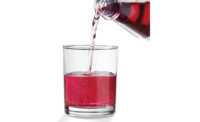Natural Solutions for Healthier Beverages
Solutions for improving the taste and texture of healthy beverages using botanical extracts, minerals and more were the focus of a recent Prepared Foods’ R&D Applications Seminar session

SOURCE: ©iStockphoto/andresr

Sodium gluconate and potassium gluconate work well in ice teas, colas, citrus and exotic flavors; while sodium lactate and potassium lactate are good in berry or cherry flavors, and also colas.
SOURCE: ©iStockphoto/pilipphoto


Solutions are available for improvement of mouthfeel, off-taste masking, neutral-tasting minerals and acid-sweetness balance in healthier beverages.
When developing healthier beverages, often solutions are needed for improving taste and texture. Off-flavors can occur with mineral fortification, sugar substitution and calorie reduction; therefore requiring off-taste masking, acid-sweetness balance and mouthfeel improvement.
When fortifying with minerals, often the target is at least 10% of the Daily Value per serving, which can be challenging. Complementary vitamins or botanicals are sometimes included, as well. A pH value below 4.0 is desirable for a stable product, as well as for imparting a similar flavor as the unfortified products.
Botanical extracts often are combined with minerals in healthier beverages, because they are perceived by consumers to be natural and have well-known health benefits due to traditional usage. Botanicals have an overall positive image and offer some new, unique and out-of-the-box ideas.
According to Rocio Aramburo, market development manager at Jungbunzlauer Inc., in his Prepared Foods’ R&D Applications Seminar titled “Natural Solutions for Healthier Beverages,” mineral fortification “in significant amounts is feasible without compromising taste or stability.”
Due to chelating properties of the organic minerals (citrates, for example), taste is not a major issue. Organic minerals generally are considered as more bioavailable than inorganic minerals. Additionally, organic minerals are highly soluble and their fast dissolution speed, make concentrations of up to 1:40 possible. However minerals act as a buffer in beverages—increasing pH—therefore, pH values below 3.5 can be difficult.
For example, a sugar-free antioxidant beverage with an excellent source of zinc is possible using a RebA (stevia), and trisodium citrate or sodium gluconate. The difference between sodium citrate and sodium gluconate is that the gluconate acts as a chelating agent and reduces the bitterness of some ingredients, such as stevia, minerals in high concentrations, botanicals and caffeine, among others, while also buffering the pH.
There also are sodium-free alternatives that can reduce bitterness, such as potassium gluconate or lactate, which can be another alternative for sodium free formulations. Sodium gluconate and potassium gluconate work well in ice teas, colas, citrus and exotic flavors; while sodium lactate and potassium lactate are good in berry or cherry flavors, and also colas. Using an off-taste masking buffer, like sodium gluconate at 0.16%, would increase the cost by only 0.2% higher than a control; when adding a masking flavor, the cost can increase by as much as 20%.
For acid sweetness balance, synthetic malic acid can be replaced by fermented acids in combination. For example, combining citric, gluconic and lactic acids, helps achieve the best acid-sweetness balance in calorie-reduced beverages containing stevia and sugar. And, when replacing malic acid with gluconic or lactic acids, there is typically no cost increase.
Aramburo also explained how mouthfeel improvement can be achieved using xanthan gum at optimum levels of approximately 0.01 to 0.025% in calorie-free or sugar-reduced near-water beverages. The recommendation is to add the minimum of 0.01% xanthan gum to sugar-reduced beverages, which will increase the cost by approximately only 0.01%. Different types of xanthan gum are easy to use during processing, and they are clear and easily soluble.
“Natural Solutions for Healthier Beverages,” Rocio Aramburo, market development manager, Jungbunzlauer Inc., Rocio.aramburo@jungbunzlauer.com, 857-636-9131
—Summary by Elizabeth Pelofske, Contributing Editor
Looking for a reprint of this article?
From high-res PDFs to custom plaques, order your copy today!








